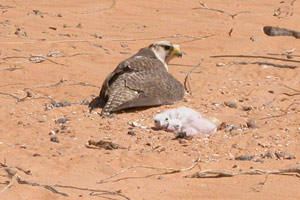Pratique | Débuter
Quand les faucons nichent au sol

Femelle de Faucon lanier (Falco biarmicus) simulant une aile cassée et s’éloignant de son nid installé sur le sol en Mauritanie.
Photographie : Volker Salewski / Malimbus
Introduction
S’il existe des rapaces qui nichent au sol, comme les busards, la plupart des faucons installent leurs nids sur des parois rocheuses ou des structures à l’abri des prédateurs terrestres. Mais il existe de rares exceptions, comme le Faucon de Nouvelle-Zélande qui nidifie la plupart du temps au sol.
Même des Falconidés généralement rupicoles peuvent occasionnellement déposer leurs oeufs à même le sol : lors d’un voyage en Mauritanie en avril 2004, Volker Salewski et Veronika Martignoli ont découvert une femelle de Faucon lanier (Falco biarmicus) couvant ses œufs sur le sable.
Cette observation remarquable a été décrite dans le numéro 27 de la revue Malimbus. Cette revue, publiée par la Société d’Ornithologie de l’Ouest Africain (SOOA), a été lancée en 1979. Elle est bilingue et exclusivement consacrée à l’ornithologie en Afrique de l’Ouest, une double originalité.
Abstract
All Accipitrids build a nest of sticks lined with softer material. Nest sites are usually in a commanding position on a cliff or in a tree, but a few species such as the harriers nest on the ground. Falcons typically nest on cliff walls or artificial structures. But there are a few exceptions, such as the the New Zealand Falcon that breeds on the ground within the forests of the archipelago : this is indeed the perfect environment for rearing chicks, but it does make them highly vulnerable to introduced predators and forestry operations. But even cliffs-dwelling species like Lanner (Falco biamicus) can install their nest on the ground when other substrates are scarce : during a trip in Mauritania in early April 2004, Volker Salewski and Veronika Martignoli found a Lanner on its nest that was a shallow bowl scraped in the sand. The description of this unusual sight was published in the issue 27 of Malimbus, a bilingual, biannual publication published by the West African Ornithological Society. Its object is to promote scientific interest in the birds of West Africa and to further the region’s ornithology.
Poursuivez la lecture de cet article, en vous abonnant dès maintenant !
Découvrez les Archives d’Ornithomedia.com
Pour seulement 10,00 €TTC/an (ou 6,00 € les 6 mois)
Profitez de plusieurs centaines d’articles en accès illimité et sans aucun engagement.
Compléments
Ouvrage recommandé
Le guide Ornitho Killian Mullarney
Sources
- Volker Salewski et Veronika Martignoli, (2005). A ground nest of the Lanner Falcon Falco biarmicus in Mauritania. Malimbus 27. pages 113-116
- Joel E. Pagel, Robert T. Patton et Brian Latta (2010). Ground Nesting of Peregrine Falcons (Falco peregrinus) Near San Diego, California. Journal of Raptor Research 44(4):323-325. http://www.bioone.org/doi/abs/10.3356/JRR-10-03.1
- Department of Conservation. Threats to New Zealand falcon/karearea http://www.doc.govt.nz/conservation/native-animals/birds/land-birds/nz-falcon-karearea/threats/
- US Fish and Wildlife Service. Frequently Asked Questions Regarding Peregrine Falcons. http://www.fws.gov/endangered/what-we-do/peregrine-falcon.html
- Potapov et al. (2001). Nest site selection in Mongolian Sakers. Proceedings of the II International Conference on the Saker Falcon and Houbara Bustard, Mongolia, 1-4 July 2000. 132-137. http://www.falcons.co.uk/mefrg/PDF/potapov1.pdf
- E. Alison Kay (1994). A Natural history of the Hawaiian Islands: selected readings II
- Richard Seaton, Edward O. Minot et John D. Holland (2010). Nest-site selection of New Zealand Falcons (Falco novaeseelandiae) in plantation forests and the implications of this to forestry management. Birds Australia. http://www.publish.csiro.au/paper/MU09050.htm
- Badassbees.com (2004). Karearea The New Zealand Falcon. http://www.badassbees.com/karearea/karearea.html




Aucun commentaire sur ce sujet
Participer à la discussion !